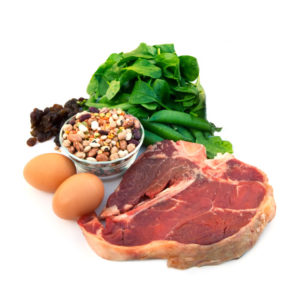Iron: How do you know you’re getting enough?
 Iron is an important nutrient that gives us energy by assisting in the transportation of oxygen to the cells in our body. Iron is especially important during the teen years because young women are growing and going through puberty which can increase energy demands. Most girls lose a small amount of iron during their period, which isn’t concerning; however the iron loss can be greater if the period is heavy and leads to iron deficiency anemia. The recommendation for females is 15 mg of iron per day while for males it is 11 mg per day. It’s hard for a person to tell if they have an iron deficiency, if your iron is low, you may have symptoms such as: unusual tiredness, increased irritability, weakness, headaches, cold hands and feet, poor appetite and/or dizziness. These symptoms can be related to other medical problems so it’s important to see your health care provider and get checked out.
Iron is an important nutrient that gives us energy by assisting in the transportation of oxygen to the cells in our body. Iron is especially important during the teen years because young women are growing and going through puberty which can increase energy demands. Most girls lose a small amount of iron during their period, which isn’t concerning; however the iron loss can be greater if the period is heavy and leads to iron deficiency anemia. The recommendation for females is 15 mg of iron per day while for males it is 11 mg per day. It’s hard for a person to tell if they have an iron deficiency, if your iron is low, you may have symptoms such as: unusual tiredness, increased irritability, weakness, headaches, cold hands and feet, poor appetite and/or dizziness. These symptoms can be related to other medical problems so it’s important to see your health care provider and get checked out.
If it turns out that your symptoms are related to iron deficiency (low iron) you can help to correct the problem by eating iron-rich foods. For example: begin your day with a balanced breakfast. Many cereals and breads are iron fortified. This means that iron is added to these products during the manufacturing process to help people meet their nutritional needs. A serving of fortified breakfast cereal will provide 18 mg of iron, fulfilling your daily needs. If you don’t like cereal or want to change up your breakfast routine, try adding something that is iron-rich for lunch or dinner such as lentil soup or a spinach salad.
Not many people know that some foods alter your body’s ability to absorb iron. For example: milk can prevent your body from absorbing the iron you get via iron-rich foods, so soy milk is a great alternative. Tea and coffee contain compounds called tannins that can also prevent your body from absorbing iron. If you are iron deficient, you should talk to your provider or dietitian about limiting intake of these drinks. However, to increase the amount of iron absorbed by your body add Vitamin C to your diet by drinking orange juice or eating a piece of fruit around the same time you eat iron-rich foods. Snacks that are iron-rich include nuts and dried fruit. A serving of cashews has 2 mg of iron, providing about 15% of your daily needs. For lunch try adding dark green vegetables to your meal such as spinach, broccoli or kale. A half cup of cooked spinach will provide 3 mg of iron. Lean meat, eggs and beans are also great sources of iron that you can have for lunch or dinner.
By increasing the amount of iron-rich foods that you eat, you can increase the iron levels in your body. If you are diagnosed with iron-deficiency your health care provider may suggest that you take an iron supplement in addition to eating foods high in iron.
-Nutrition Student Laura

